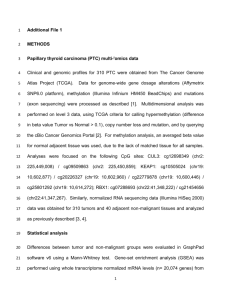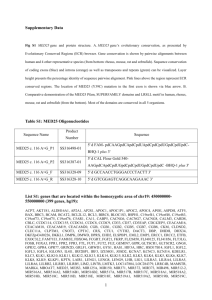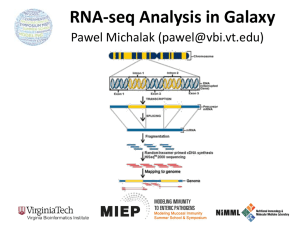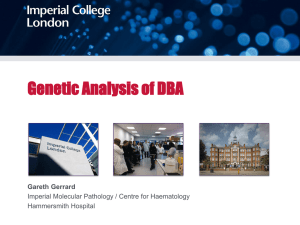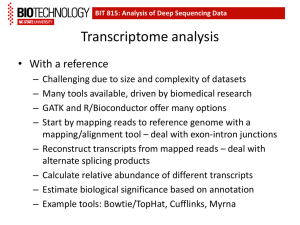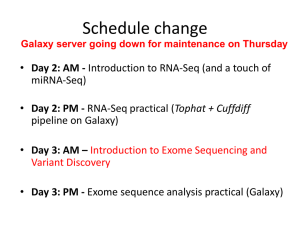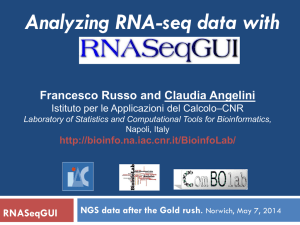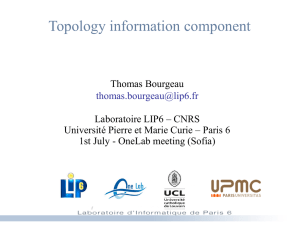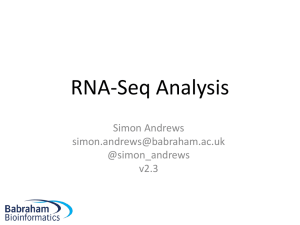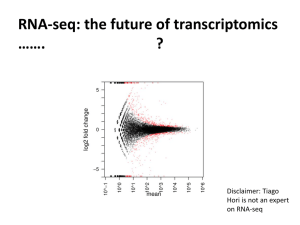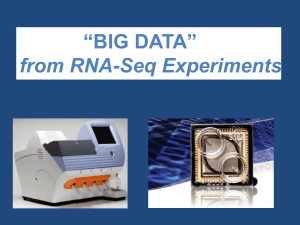Hands-on Tutorial: RNA-seq Analysis using Cluster Computing
advertisement
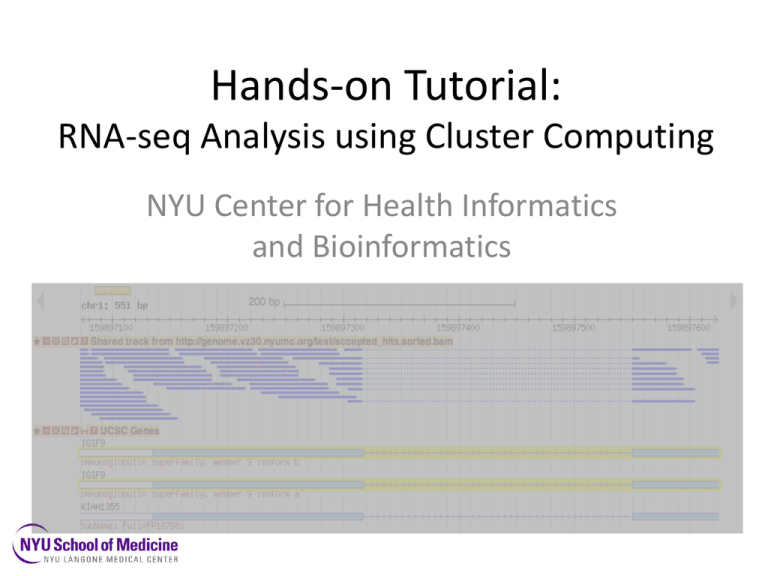
Hands-on Tutorial: RNA-seq Analysis using Cluster Computing NYU Center for Health Informatics and Bioinformatics • • • • • • • Intro to RNA-seq Quick review of ssh login to HPC cluster 10 essential Linux commands HPC Environment Modules Sun Grid Engine commands for batch jobs Reference Genomes (igenomes) basic RNA-seq workflow: FASTqc > Tophat > Cufflinks > Cuffdiff • Creating an SGE script for your workflow RNA-seq • Gene expression can be estimated by measuring RNA in the cell • Northern Blots: one gene per experiment • Microarray: pre-built probes for lots of genes • RNA-seq: sequence and count millions of RNA molecules present in the sample – RNA-seq has larger dynamic range, correlates more closely with qPCR, identifies transcript isoforms, discovers novel genes Extract RNA from samples biological replicates for every condition! James Hadfield, BiteSizeBio.com Illumina mRNA Sequencing RNA-Seq: Method Random primer PCR AAAA AAAAAAA AAAAAA Poly-A selection Fragment & size-select cDNAsample Relative # of reads Illumina Sequencing Genome position FASTQ format: sequence + qualilty @SRR350953.5 MENDEL_0047_FC62MN8AAXX:1:1:1646:938 length=152 NTCTTTTTCTTTCCTCTTTTGCCAACTTCAGCTAAATAGGAGCTACACTGATTAGGCAGAAACTTGATTAACAGGGCTTAA GGTAACCTTGTTGTAGGCCGTTTTGTAGCACTCAAAGCAATTGGTACCTCAACTGCAAAAGTCCTTGGCCC +SRR350953.5 MENDEL_0047_FC62MN8AAXX:1:1:1646:938 length=152 +50000222C@@@@@22::::8888898989::::::<<<:<<<<<<:<<<<::<<:::::<<<<<:<:<<<IIIIIGFEE GGGGGGGII@IGDGBGGGGGGDDIIGIIEGIGG>GGGGGGDGGGGGIIHIIBIIIGIIIHIIIIGII @SRR350953.6 MENDEL_0047_FC62MN8AAXX:1:1:1686:935 length=152 NATTTTTACTAGTTTATTCTAGAACAGAGCATAAACTACTATTCAATAAACGTATGAAGCACTACTCACCTCCATTAACAT GACGTTTTTCCCTAATCTGATGGGTCATTATGACCAGAGTATTGCCGCGGTGGAAATGGAGGTGAGTAGTG +SRR350953.6 MENDEL_0047_FC62MN8AAXX:1:1:1686:935 length=152 #--+83355@@@CC@C22@@C@@CC@@C@@@CC@@@@@@@@@@@@C?C22@@C@:::::@@@@@@C@@@@@@@@CIGIHIIDGI GIIIIHHIIHGHHIIHHIFIIIIIHIIIIIIBIIIEIFGIIIFGFIBGDGGGGGGFIGDIFGADGAE @SRR350953.7 MENDEL_0047_FC62MN8AAXX:1:1:1724:932 length=152 NTGTGATAGGCTTTGTCCATTCTGGAAACTCAATATTACTTGCGAGTCCTCAAAGGTAATTTTTGCTATTGCCAATATTCC TCAGAGGAAAAAAGATACAATACTATGTTTTATCTAAATTAGCATTAGAAAAAAAATCTTTCATTAGGTGT +SRR350953.7 MENDEL_0047_FC62MN8AAXX:1:1:1724:932 length=152 #.,')-2-/@@@@@@@@@@<:<<:778789979888889:::::99999<<::<:::::<<<<<@@@@@::::::IHIGIGGGGGGDGG DGGDDDIHIHIIIII8GGGGGIIHHIIIGIIGIBIGIIIIEIHGGFIHHIIIIIIIGIIFIG NA sequencing is superior to other gene g methods RNA-seq vs. qPCR ge Accuracy and Sensitivity Data Analysis Pipeline Reads Alignments Read counts gene HTC.neg.rep1 CD79A 480.6384705 MZB1 341.2034394 FDCSP 144.6685958 CXCL13 224.285861 FCRLA 98.49801945 SLAMF7 250.0736081 PHEX 4.626536748 POU2AF1 305.5975177 SPIB 126.2189589 LTB 263.2459306 IL2RG 383.5641411 CD19 111.8179974 Differential Expression HTC.pos. HTC.pos PTC.neg PTC.ne gene rep2 .rep3 .rep1 g.rep2 logFC PValue FDR CD79A 38.04 36.02 0.74 0.26 -6.89 5.71E-17 8.49E-13 MZB1 22.80 45.43 0.21 0.50 -6.58 1.90E-16 1.41E-12 FDCSP 10.20 2.29 0.17 0.00 -8.89 1.27E-15 5.08E-12 CXCL13 16.37 6.02 0.04 0.05 -7.25 1.46E-15 5.08E-12 FCRLA 8.42 6.61 0.16 0.03 -7.37 1.71E-15 5.08E-12 SLAMF7 19.00 36.71 2.36 1.58 -4.60 4.48E-15 1.11E-11 PHEX 0.24 2.93 81.67 41.51 4.31 2.52E-14 5.02E-11 POU2AF1 33.49 23.90 3.58 3.12 -4.60 2.73E-14 5.02E-11 SPIB 7.74 1.62 0.24 0.16 -6.50 3.25E-14 5.02E-11 LTB 18.90 10.14 2.40 1.54 -4.56 3.54E-14 5.02E-11 IL2RG 33.53 37.38 6.44 5.12 -3.83 3.72E-14 5.02E-11 CD19 13.77 1.71 0.64 0.34 -6.34 4.88E-14 6.04E-11 LOC96610 50.85 130.54 8.28 10.19 -4.43 6.61E-13 7.55E-10 IGLL5 392.76 498.21 0.84 2.54 -6.00 7.28E-13 7.73E-10 PIM2 33.75 104.19 10.83 9.86 -3.45 7.95E-13 7.87E-10 Map reads to genome, count reads per gene, normalize, compare counts across different samples (statistical test) RNA-seq Informatics Workflow • • • • • • • Check error rate Filter out rRNA Align to genome (including splice junctions) Sum reads for each gene Differential expression Alternatively spliced exons Sequence variants (SNPs, indels, translocations) CHIBI HPC Cluster: Phoenix Custom-designed, powerful, state-of-the-art, power- and cost-efficient, shared computing resource. • 2 Head “Login” Nodes • 2 Intel Sandy Bridge 2.6GHz CPUs, 16 processing cores, 128GB Random Access Memory (RAM) each. • 64 Compute “Worker” Nodes • 2 Intel CPUs, 16 processing cores, 128GB RAM each, 8 GB/core. • 5 GPU Compute Nodes • 2 Intel CPUs, 16 processing cores, 128 GB RAM each • NVIDIA Tesla Kepler K20 GPU accelerator (2496 cores, 1.17 TFLOPS) • 1 High Memory Compute Node • 4 Intel CPUs, 32 processing cores, 1 TB RAM • Networks: Private 10Gbit Message Passing Network Private 10Gbit Data (Input-Output) Network to Primary Isilon data storage cluster. Public 10Gbit interface to the Enterprise Campus Network • Data Storage: 1 PetaByte (1015 Bytes) raw High-throughput, Scalable, EMC/Isilon Data Storage Clusters & mirror backup Total CPU Cores: 1,170 Total GPU Cores: 12,480 Total RAM: 10TB Performance: (est.) 28TFLOPS ssh login to phoenix • Username: your NYULMC Kerberos id • Hostname: phoenix.med.nyu.edu > ssh –X userID@phoenix.nyumc.org • We prefer to use the more secure two-factor “key pair” authentication rather than passwords. This is a minimal list of Linux commands that you must know for file management: • • • • • ls (list) cd (change directory) cp (copy) mv (move) rm (remove/delete) • mkdir (make directory) • rmdir (remove directory) • pwd (print working directory) • more (view by page) • cat (view entire file on screen) • All of these commands can be modified with many options. • Learn to use Linux ‘man’ pages for more information. Sun Grid Engine • Commands for your program go in a shell script • Can include a series of commands that call different programs in a workflow • Submit the shell script to a “queue” with the SGE qsub command • can build a loop that runs the same commands on many data files, each one becomes a separate ‘job’ and can run on a different compute node SGE: Useful Commands • qsub • qstat • qacct • qdel • qlogin • Submit job. Check status of running jobs or queues. Get accounting information on finished jobs. Delete (kill) running job. Start interactive shell on compute node. Use sparingly and remember to logout when finished. Load Your Programs • The Phoenix HPC system has many users and a lot of installed software • Different versions of some programs are available • Each program requires a specific set of supporting libraries, data, etc. • These are managed with Environment Modules Environment Module Commands • module avail • module list List available modules. List currently loaded modules. • module load name Load named module. • module unload name Unload named module. • module help name See help on named module. igenomes • igenomes is a set of common reference genomes pre-installed on the cluster for everyone to use. • You access it by first loading the igenomes module: > module load igenomes • This creates an alias $IGENOMES_ROOT which points to the Reference Genome files. Software Workflow FASTQC > TopHat > Cufflinks ||> Cuffdiff Can use qlogin to run one program at a time interactively from command line module load fastqc module load tophat module load cufflinks module load igenomes FASTQC shows average sequence quality per base along reads, base distribution, also finds overrepresented sequences: > module load fastqc > fastqc -o . /ifs/data/tutorial/JZ5_R1.chr19.fastq > firefox JZ5_R1.chr19_fastq/report.html FASTQC TopHat/Cufflinks RNA-seq can be used to directly detect alternatively spliced mRNAs. Trapnell C et al. Bioinformatics 2009;25:1105-1111 TopHat aligns FASTQ data files to a Reference Genome. It also makes use of genome annotation (gene names, location of exons on genome). You have the option to find new splice junctions and align reads outside of known genes/exons >module load bowtie2 >module load tophat > tophat –o JZ5_output --transcriptome-index $Ref_Genome/genes $Ref_Genome/Bowtie2Index/genome /ifs/data/tutorial/JZ5_R1.chr19.fastq There are two workflows you can choose from when looking for differentially expressed and regulated genes using the Cufflinks package. The first workflow is simpler and is a good choice when you aren't looking for novel genes and transcripts. This workflow requires that you not only have a reference genome, but also a reference gene annotation in GFF format. The second workflow, which includes steps to discover new genes and new splice variants of known genes, is more complex and requires more computing power. The second workflow can use and augment a reference gene annotation GFF if one is available. OPTIONAL Cufflinks counts reads per gene, identifies novel transcript isoforms writes a new GTF file. This is the optional, more complex workflow. > module load cufflinks > cufflinks –g $REF_ANNOT/genes.gtf S1_out/accepted_hits.bam • Cuffdiff calculates differential expression between two sets of RNA-seq data files (treatment vs. control), using BAM files created by TopHat. cuffdiff $REF_ANNOT/genes.gtf T1_r1_hits.bam,T1_r2_hits.bam C2_r1_hits.bam,C2_r2_hits.bam tophat.sge script #!/bin/bash #$ -S /bin/bash #$ -cwd module load igenomes module load samtools/0.1.19 module load bowtie2 module load tophat module load cufflinks tophat –o $1 --transcriptome-index $IGENOMES_ROOT/Homo_sapiens/UCSC/hg19/Annotation/Transcriptome/genes $IGENOMES_ROOT/Homo_sapiens/UCSC/hg19/Sequence/Bowtie2Index/g enome $2 Run the script with qsub > qsub tophat.sge JZ5 /ifs/data/tutorial/JZ5_R1.chr19.fastq > qsub tophat.sge JZ7 /ifs/data/tutorial/JZ7_R1.chr19.fastq > qstat qlogin for Cuffdiff cuffdiff $Ref_Annotation data1.bam data2.bam > qlogin > cuffdiff –o Diff $IGENOMES_ROOT/Homo_sapiens/UCSC/hg19/Anno tation/Genes/genes.gtf JZ5/accepted_hits.bam JZ7/accepted_hits.bam Cuffdiff Result gene locus sample_1 sample_2 status value_1 value_2 log2(fold_change) test_stat p_value q_value significant ATP1A3 chr19:42470733-42498428 q1 q2 OK 1.21246 29.7143 4.61515 -3.12585 0.00177293 0.0496814 yes C19orf38 chr19:10959105-10980360 q1 q2 OK 7.21903 147.921 4.35687 -3.37125 0.00074829 0.0255025 yes CD37 chr19:49838676-49865714 q1 q2 OK 50.3636 4202.94 6.38288 -3.18846 0.00143032 0.0429436 yes CD70 chr19:6585849-6591163 q1 q2 OK 0.429097 41.8858 6.60901 -3.32984 0.000868954 0.0281591 yes CD79A chr19:42381189-42385439 q1 q2 OK 3.56079 7065.35 10.9543 -8.85453 0 0 yes CLEC17A chr19:14693895-14721956 q1 q2 OK 0.329253 123.814 8.55476 -4.4262 9.59083e-06 0.000930311 yes CNTD2 chr19:40728114-40732597 q1 q2 OK 94.8723 4.50887 -4.39515 3.38374 0.000715053 0.0250467 yes CRLF1 chr19:18704034-18717660 q1 q2 OK 451.785 31.8185 -3.8277 3.15241 0.00161928 0.046407 yes EBI3 chr19:4229539-4237524 q1 q2 OK 10.7606 252.04 4.54982 -3.46471 0.000530804 0.0196866 yes FAM129C chr19:17634109-17664648 q1 q2 OK 0.528184 243.529 8.84884 -5.58585 2.32556e-08 5.86507e-06 yes FCER2 chr19:7753642-7767032 q1 q2 OK 0.430612 664.696 10.5921 -4.53907 5.65033e-06 0.000647734 yes FCGBP chr19:40353962-40440533 q1 q2 OK 714.292 53.2831 -3.74476 3.92369 8.72025e-05 0.00478097 yes FLJ22184 chr19:7933604-7939326 q1 q2 OK 91.0657 4.4967 -4.33997 3.32922 0.000870901 0.0281591 yes FPR3 chr19:52298410-52329334 q1 q2 OK 19.9929 557.07 4.8003 -4.01145 6.03479e-05 0.00362845 yes GZMM chr19:544026-549919 q1 q2 OK 7.3703 547.332 6.21455 -5.08715 3.63493e-07 6.54807e-05 yes HPN chr19:35531409-35597208 q1 q2 OK 1851.49 111.135 -4.0583 3.1732 0.00150768 0.0442135 yes ICAM3 chr19:10444451-10450345 q1 q2 OK 93.4318 1447.49 3.95349 -3.57653 0.000348183 0.01514 yes IGFLR1 chr19:36230150-36233351 q1 q2 OK 46.3094 692.82 3.9031 -3.18998 0.0014228 0.0429436 yes JAK3 chr19:17935592-17958841 q1 q2 OK 41.7086 560.413 3.74807 -3.49018 0.000482698 0.0190213 yes JSRP1 chr19:2252249-2256422 q1 q2 OK 2.26314 308.507 7.09083 -5.73067 1.00034e-08 3.15357e-06 yes Integrated Genomics Viewer • IGV is a nice way to view the actual reads in your BAM files aligned to the reference genome (with gene annotation) • Download Java app from Broad website • Choose Mouse genome • Load BAM files. Prepare index for IGV • IGV requires a .bai index file for each BAM file to rapidly find and display read data at a specific position on the genome • Use samtools to make the index > module load samtools > samtools index Tophat/JZ5/accepted_hits.bam Tophat/JZ5/accepted_hits.bai FTP download of BAM and .bai files • Mac: Filezilla, Cyberduck • Win: Filezilla or PSFTP, & Pageant (from PuTTY website) IGV screen of diff expr. gene Thanks Constantin Aliferis Director, NYU Center for Health Informatics & Bioinformatics (CHIBI) The NYU Sequencing Informatics Group The NYU Genome Technology Center Director: Adriana Heguy Staff: Berrin Baysa Elisa Venturini Igor Dolgalev Zuojian Tang Hao Chen Alexander Alekseyenko Steven Shen Phillip Ross Smith Jinhua Wang Alexander Statnikov NYU Office of Collaborative Science The NYU Clinical and Translational Science Institute, Directors: Bruce Cronstein Judith Hochman CHBI High Performance Computing Facility Efstratios Efstathiadis Eric Peskin All of our scientific collaborators, including: Max Costa Claude Desplan David Fenyo Daniel Merulo David Roth Kenneth Cadwell Matthew Murtha/Lisa Dailey
